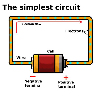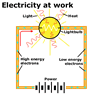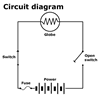A circuit is a complete loop. An electrical circuit is a conducting loop of wire and an energy source like a battery that allows electrons to travel move around. The word "circuit" is commonly used to describe car racing tracks or running tracks, where the circuit is continuous. In an electrical circuit, the path for an electric current is a continuous circuit of wire.
Simple circuits
 The simplest electrical circuit consists of a source of electrical
energy (a cell or battery) and a single wire. When one end of the wire
is connected to the positive terminal of the cell and the other to the
negative terminal, a electrical current flows through the circuit.
The simplest electrical circuit consists of a source of electrical
energy (a cell or battery) and a single wire. When one end of the wire
is connected to the positive terminal of the cell and the other to the
negative terminal, a electrical current flows through the circuit.
In this simple circuit, no useful energy transformation occurs - all that happens is that the cell loses energy and "goes flat". This will happen because there is a limited supply of energy in the cell to push electrons around the circuit and because there is very little resistance in the circuit, it rapidly discharges its energy from the cell. The rapid energy transformation makes the wire very hot, which quickly dissipates the energy from the cell. This type of circuit is commonly known as a "short circuit".
A circuit that does work
 If a light globe is put into the circuit, it acts as a resistance
to the flow of electrons. Some of the energy carried by the electrons
passing through the globe is transformed into light and thermal energy.
This is now a useful use of the energy provided by the cell. Other applications
involving simple circuits are electric heaters and motors where the electrical
energy is transformed to heat and motion.
If a light globe is put into the circuit, it acts as a resistance
to the flow of electrons. Some of the energy carried by the electrons
passing through the globe is transformed into light and thermal energy.
This is now a useful use of the energy provided by the cell. Other applications
involving simple circuits are electric heaters and motors where the electrical
energy is transformed to heat and motion.
Going flat
![]() When a globe is placed into an electric circuit the current passes
through the filament. The filament is made from a metal (eg. tungsten)
that resists the electron flow. This makes the metal heat up and give
off light and thermal energy. Usually, white hot metal would just burn
up as it reacts with oxygen in the air. A light globe is sealed and contains
a small amount of inert gas that does not react with the metal filament.
Over time, the energy gets converted by the globe into light and thermal
energy until there is no more energy left or not enough to maintain the
current. When this happens the cell is said to be flat. Some globes have
such a high resistance that they can drain cells within seconds. All electrical
devices transform electrical energy into another form of energy. There
is always only a finite amount of energy that can be converted.
When a globe is placed into an electric circuit the current passes
through the filament. The filament is made from a metal (eg. tungsten)
that resists the electron flow. This makes the metal heat up and give
off light and thermal energy. Usually, white hot metal would just burn
up as it reacts with oxygen in the air. A light globe is sealed and contains
a small amount of inert gas that does not react with the metal filament.
Over time, the energy gets converted by the globe into light and thermal
energy until there is no more energy left or not enough to maintain the
current. When this happens the cell is said to be flat. Some globes have
such a high resistance that they can drain cells within seconds. All electrical
devices transform electrical energy into another form of energy. There
is always only a finite amount of energy that can be converted.
Stopping the flow
 Another important part of a simple circuit is a switch. A switch
opens and closes a circuit, allowing electrons to flow, or stopping them
completely.
Another important part of a simple circuit is a switch. A switch
opens and closes a circuit, allowing electrons to flow, or stopping them
completely.
A switch then is used to control the flow of electrons. Switches are visible all around you, in your home, on your computer and on the multitude of electrical devices in our modern society.

|
Circuit with a switch. |
Batteries
A common, portable source of electrical energy is the standard dry cell,
each cell producing 1.5 volts. By linking cells end to end (in series)
the voltage can be increased. A group of cells is called a battery, a
9 volt battery contains six cells 1.5 volt cells connected in series.
See the topic Batteries
in series and parallel for more on connecting batteries in circuits.

| Copyright owned by the State of Victoria (Department of Education and Early Childhood Development). Used with Permission. |